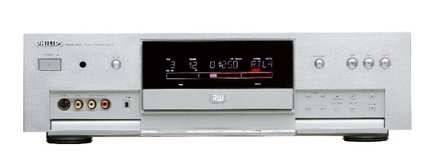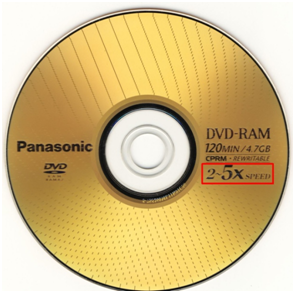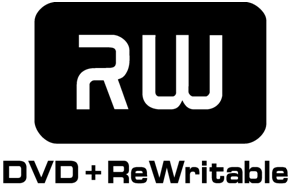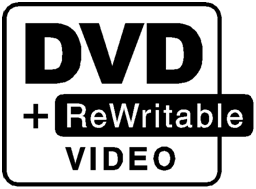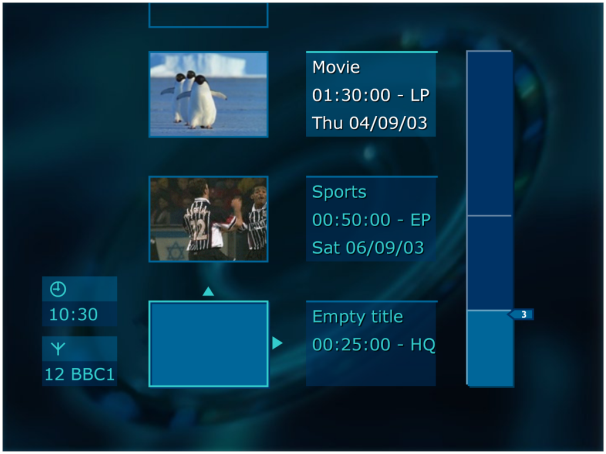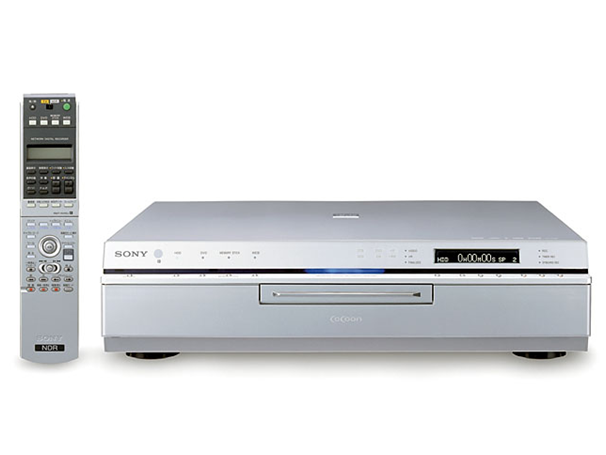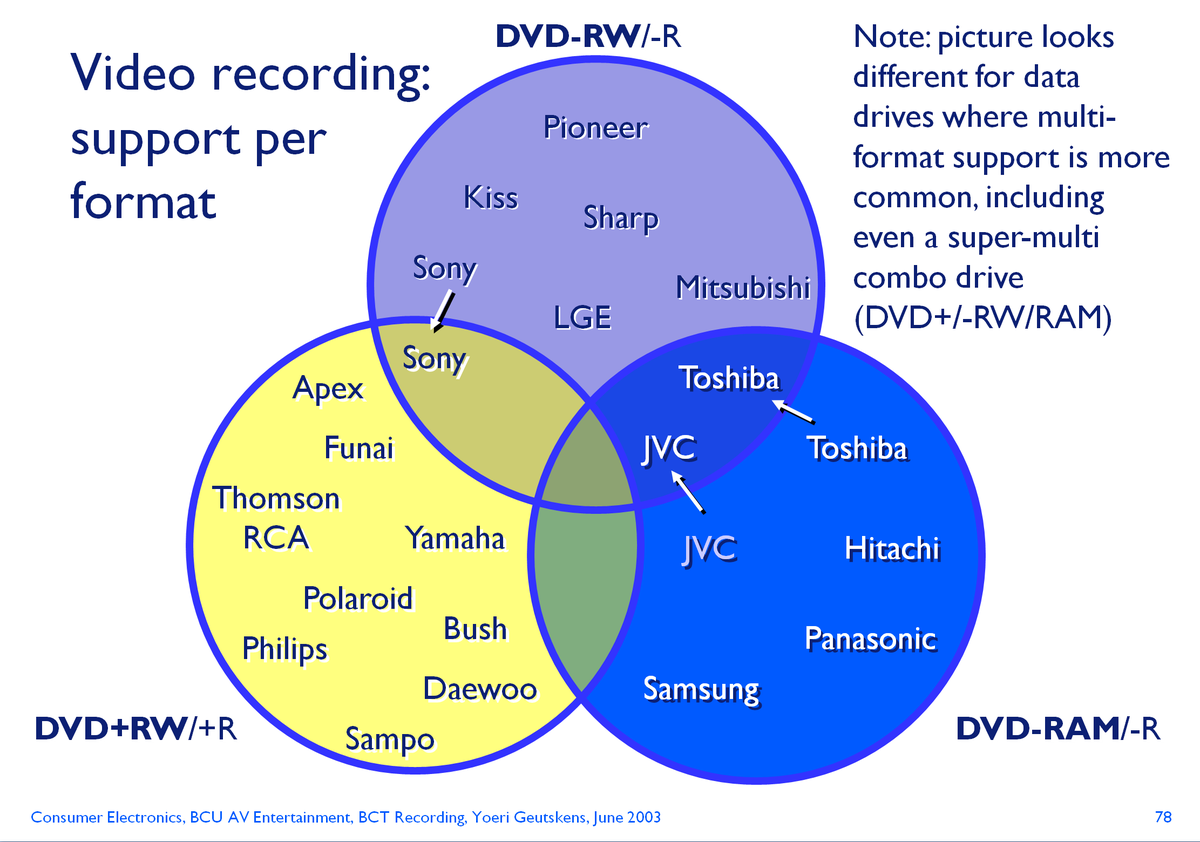Triggered by this tweet https://twitter.com/laserdiscdream/status/1251639791940067333">https://twitter.com/laserdisc... it got me thinking. My memory of this could be getting hazy after 20 years but this may be right. Pioneer beat us to market with our (Philips’) own invention after we explained it to them trying to win them into our camp. [thread]
I was Product Manager DVD Recorder at Philips Consumer Electronics where we invented the first two-way compatible DVD Recorder, which means that not only could you play existing DVD-Video discs on these devices, you could also play discs they recorded on existing DVD-V players.
Here’s (in the middle) the logo I personally designed for that. On the right the logo for DVD+ReWritable (designed by Sony; more about that further down). (Note how the three logos together almost read like DVD + RW)
Here’s that DVD Recorder, the DVDR1000, which made it to market in 2001 at a price of $1,999/€1,999.
A brief summary. I’ll try to keep it concise, but it’s quite a story.
After the DVD-ROM and DVD-Video standards had been set and the first DVD-Video players came to market circa 1997, the DVD Forum set out to complete the other three of the five ‘books’: DVD-Audio, the write-once format and DVD rewritable format.
Now recording was quite literally an after-thought. The DVD-Video format had been devised for publishing on replicated discs, a format for studios’ home entertainment divisions >
> where it doesn’t matter much whether the preparation of the disc is a matter of minutes, hours or days as it’s part of a process of many weeks of post-production, encoding, authoring, mastering, etc. by professionals.
The DVD-Video format lent itself particularly poorly to real-time recording. That’s because within the Program Stream on the disc (MPEG2 video + audio + all the necessary metadata) pointers were embedded that tell a player where to jump to when fast forwarding 2x, 4x, 8x, 16x etc
Because of DVD’s use of variable bit rate (VBR) encoding, you could not know in front where those points were going to be. This made it a necessity to use two-pass encoding for DVD.
After the whole program had been encoded you could fill in these pointers. This does not equate real-time recording.
That’s why the DVD Forum had come up with a new format, ‘VR’ for Video Recording. This format you could record in real-time but it was different from DVD-Video so the existing players could not handle this format.
But this is only half the compatibility story – the logical format and data on it. At least as important is the physical format. Here, it gets political.
The DVD Forum consisted of 10 founding companies – Matsushita (now Panasonic), Toshiba, Mitsubishi, Hitachi, JVC, Pioneer, Sony, Philips, Thomson and Time Warner.
It was founded (following suggestions from IBM, among others) after two competing, incompatible formats almost reached the market: MMCD (MultiMedia Compact Disc) by Sony & Philips, and SD (Super Density Disc) by Matushita and Toshiba.
(In case you& #39;re interested, here& #39;s a short thread about MMCD and SD: https://twitter.com/YoeriGeutskens/status/978686909185654789)">https://twitter.com/YoeriGeut...
The Japanese Ministry of International Trade and Industry, MITI, probably played a key role behind the scenes of the Forum.
Sony and Philips had together developed the Compact Disc, as a sort of small form factor audio-only spin-off of Philips LaserVision format. As you no doubt know , the CD became a massive success, guaranteeing a fat royalty stream for both companies for years,
or actually two decades. Matsushita and Toshiba were particularly unhappy about having to pay all these royalties (patent license fees) and wanted to build the replacement of CD.
Matsushita’s first attempt at that had been a recordable disc format for data storage named PD (originally PowerDisc, IIRC, but later explained as ‘Phase-change Dual’).
This disc was also 12cm and could hold 650 MB but was held in a cartridge and wholly incompatible with CD. It did not become a big success, as opposed to CD-R and later CD-RW.
It was like an large-capacity optical floppy disk, or a big data storage equivalent of Sony& #39;s proprietary MiniDisc format.
Their second attempt was SD, which (like MMCD) was cancelled just before it could come to market.
Their second attempt was SD, which (like MMCD) was cancelled just before it could come to market.
If it had, it would have been a format war very much like the later Blu-ray Disc vs HD-DVD battle, which followed pretty much the same battle lines, except Matsushita/Panasonic had wisely changed camps.
The third attempt was DVD-Audio @DVD_Audio, aiming to replace the Audio CD, but this had to compete with Super Audio CD (SACD) by Sony and Philips, which is a separate story in its own right, in which I was also personally involved. Perhaps more about that later.
The fourth attempt was the recordable DVD. Now back to the forum. This was not quite a democratic organization. It was heavily dominated by Matsushita and Toshiba, which is why DVD mostly used their (SD) patents, and hardly anything from Sony’s and Philips’s (MMCD) IP >
> except the dual-layer option (MMCD has been developed as dual-layer single-sided, SD as double-sided single-layer; DVDs could be dual-layer _and_ double-sided), and some IP relating to modulation or error correction, I can’t recall the details.
That’s how the Forum officially decided that the ‘write many times’ format would be DVD-RAM, which was Matsushita’s PD disc upgraded to 4.7 GB (initially actually 2.6 GB). Technology Connections ( #Techconnectify) has a video on this.
DVD-RAM has very little in common with DVD-ROM except those three letters and a 12-cm optical disc. Even at physical level everything is different, with sectors hard-coded on the disc that you can see with the naked eye. It’s different in everything except name.
The write-once format had been contributed mainly by Pioneer and was reluctantly accepted by Matsushita and Toshiba. Pioneer’s DVD-RW format was rejected and also the technologies (= patent IP) proposed by Sony and Philips were,
which led Pioneer to go their own way outside the forum, and led Sony and Philips to start their own alliance together with Thomson, Yamaha, Mitshubishi Chemical/Vebatim, Ricoh, Dell and HP.
Originally called the 6C Alliance (when it consisted of six companies) but soon rebranded the DVD+RW Alliance, when DVD+RW was chosen as the format’s name, and further specified and standardized outside of the DVD Forum.
Of course the Forum object to this name but their resistance was futile. The DVD+RW Alliance could not use the Forum’s DVD logos but they could use these letters.
And frankly, DVD+RW was a lot more like DVD than DVD-RAM was. Our motto: “If it looks like a duck, it walks like a duck, if it quacks like a duck, it’s a duck”
On the left, the DVD+RW logo Sony designed. No resemblance to the DVD family of logos but hearkening back to the Compact Disc logo in a hard to see way, with its combination of straight lines and curves. On the right, the logo we designed at Philips.
Unfortunately this came too late and the 6C went with the Sony design.
Pioneer had also been invited to join but chose to go their own way, being very confident about their own abilities.
DVD+RW and DVD-RW (phase-change formats like CD-RW), and especially the later DVD+R write-once format and DVD-R (using organic dye which is quite literally burned by a laser, like CD-R) had very good compatibility with DVD-ROM. The main difference was slightly lower reflectivity.
Now back to the way data is recorded on the disc. Because the VR format was anyway incompatible with DVD-Video, Matsushita and Toshiba reasoned it didn’t matter if the physical format was also incompatible, so DVD-RAM would be fine.
At Philips, we begged to differ. Once of my colleagues had come up with a very clever trick. Those forward pointers I mentioned earlier, we filled in for the first few seconds – the video in the memory buffer –
but beyond that we filled them with the hex value ‘FF’, which according to the spec means you simply need to jump to the next segment.
This was a bit of fudging but it worked. It meant fast-forward speeds were not accurate anymore, but that was an acceptable compromise. This way we could record DVD-Video format “compliant” discs in real time.
A recording was ready within mere seconds after you pressed stop. Only if not enough disc area was recorded yet, we had to record lots of zeros in the blank space so that players would not get lost when they jumped too far.
And they had to be finalized briefly to offer full compatibility. Of course, on the RW formats this finalizing was not as final as the name suggests and could be undone and redone over and over.
Our proof of concept worked, and Philips demonstrated this at the IFA in Berlin in 1999 (not in the public area but in a demo suite in the dealer area), where we captured eople when they came into the suite,
then recorded this while I gave a brief powerpoint presentation about the concept, and then played the disc on a player chosen by the audience, from a selection of a Pioneer, a Sony, and even a Panasonic.
At this moment, the recorder was not a finalized product. It was two cubic meters of equipment, elegantly hidden behind the wall of the suite, operated by two engineers.
They had added a little LED to the prototype drive by which they could let me know if the recording had succeeded or if I needed to stretch my talk a little while they did a retry : )
Of course, it would have been great if the three competing formats had been reduced to two, if Pioneer had joined Sony and Philips, so we explained our format to them in order to persuade them, but they declined, sadly.
There was more to the format than the fudging of the forward pointers. There were certain bit settings for identifying a disc as recordable or read-only, that required manipulating. My first patent is about this. https://patents.google.com/patent/WO2003019557A1/en">https://patents.google.com/patent/WO...
We also specified some specific data on the disc that worked as a table of contents, and what we called an Index Picture Screen, which was a visual menu of the recordings, authored in such a way that this was also playable on DVD players and usable for navigation.
(The bar on the right and tuner/timer info on the left are only visible in the recorder UI, the thumbnails, title info and navigation arrows are also visible when you put this disc in a DVD player)
This we called the DVD+VR format (for Video Recording on the DVD+RW format, and later DVD+R).
Pioneer now knew how to do it (which they said connected well to ideas they had themselves) and added this to their own DVD Recorder, which initially had used the DVD Forum& #39;s VR format devised for DVD-RAM but then applied on the DVD-RW format.
Pioneer were faster and beat us to market with it, launching in 2000 or so in Japan and in the U.S. and Europe a few months after Philips (autumn 2001).
Still, their products was a bit more complicated because it offered both recording in the incompatible DVD-VR format and another mode, ‘Video mode’ similar to DVD+VR which was compatible with DVD-Video.
Of course, this compatibility was a key feature, which was what we knew all along. We had carried out consumer interviews in 1998, in Europe, when DVD was barely introduced.
This was very funny because some consumers were not even aware of DVD yet, and thought what we described must be LaserDisc.
Anyway, what the research taught us was that what made a DVD Recorder was that it recorded discs that could play on existing DVD players. And in Europe (and Japan) this was an important aspect.
People were not willing to give up their VCR for a device that couldn’t record. VHS rental and sell-through were big, but recording was an important application.
Much more so than in North America, which was more of a playback market than a recording one, and DVD-Video was a hit from day one, even if it couldn’t record.
Sony’s position was a complicated one. If I recall correctly, their consumer AV division wanted to pursue DVD-RW. Sony’s business unit responsible for PC peripherals wanted to go with DVD+RW,
whereas yet another division (perhaps the video entertainment one) wanted to go with the new format Sony was working on.
You see, when in 1996 the DVD format was forged and Sony and Philips were royally screwed over, Sony vowed revenge and immediately started working on a successor format to replace DVD.
Initially this was based on a red laser, had 9 GB capacity per layer, and was made for recording in mind from the start – not as an afterthought.
Sony wanted to call it VDR for Video Disc Recorder but when Philips joined in 1997 it was changed to DVR, as feedback from America suggested names starting with “VD” might not be a great idea...
I joined this standardization effort in February 1998 and participated in a number of meetings in Sony’s HQ in Tokyo and Philips’ offices in Eindhoven.
Philips continued to develop this format together with Sony. When blue lasers became available, those were adopted and the disc capacity grew significantly. This format eventually became known as Blu-ray Disc.
By 1999 or so, Panasonic joined in, followed by Pioneer, or the other way round – an interesting shift in allegiances. Toshiba went their own way, developing HD-DVD together with long-time partner Time Warner.
By October of 1998 I was taken off this project and assigned with a different task. The lab experiments that gave rise to the DVD+VR format had proven successful and the DVD+RW format had had some major upgrades, going from a 3.0 GB CAV-only format to a 4.7 GB CLV format.
Sony was still confident they could finalize the new format and products based on it in the short term but Philips was not. Philips was confident however this timeframe was realistic for a DVD Recorder based on DVD+RW.
So we binned the spec I had been writing for a product based on the advanced format and started pretty much from scratch with a spec for a DVD Recorder based on DVD+RW.
I guess in hindsight it’s fair to say Philips’ view was more realistic than Sony’s. If believe Sony initially (in Japan) launched a DVD-RW recorder, but then went to dual-format DVD-RW/+RW when they launched new, cheaper products in the rest of the world.
Here& #39;s what the situation looked like in 2003. Over time, DVD+RW/+R got the most populated with a lot of Asian low-cost competition entering. Years later, this gave me the idea to begin mapping HDR format support :-)

 Read on Twitter
Read on Twitter
